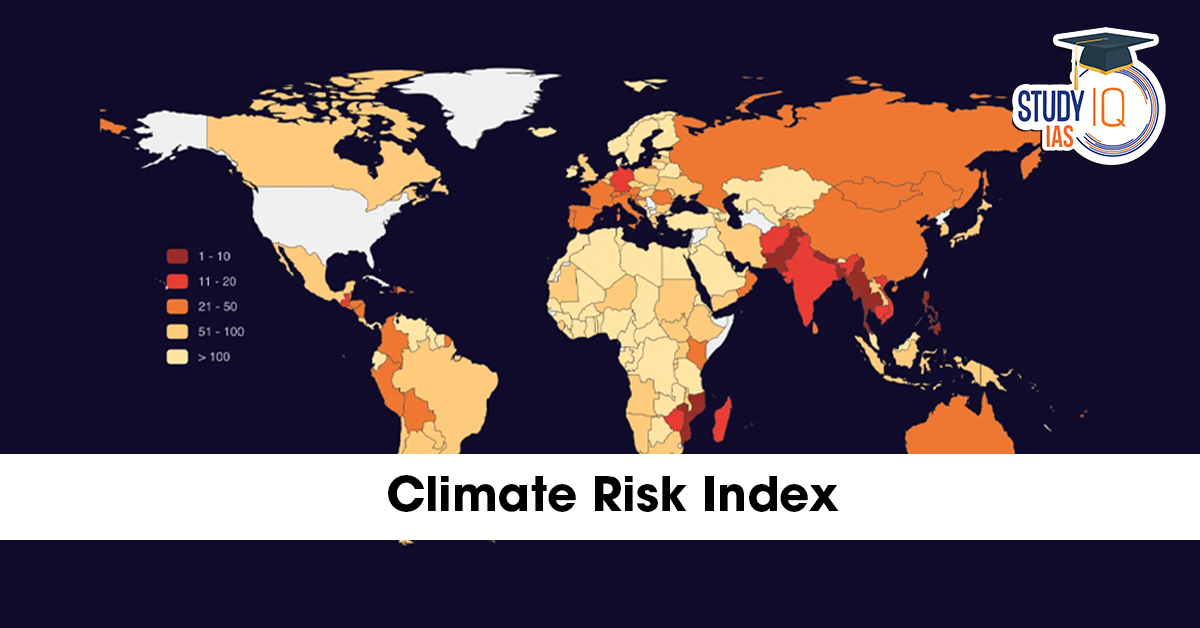Table of Contents
Climate change is intensifying worldwide, and its impacts are now more frequent, deadly, and economically devastating. To assess how countries are affected by extreme weather events, the Climate Risk Index (CRI) is one of the most authoritative and cited global reports. Recently released during COP30, the CRI 2026 places India as the 9th most affected country by climate-related disasters over the last 30 years (1995–2024).
For UPSC aspirants, policymakers, researchers, and environmental experts, understanding the CRI is crucial due to its data-driven insights, global ranking system, and direct relevance to climate policy.
What is the Climate Risk Index (CRI)?
The Climate Risk Index (CRI) is an annual analytical report published by Germanwatch, a Bonn-based environmental think tank. First released in 2006, it is one of the world’s longest-running climate impact-related indices.
CRI Measures:
The index evaluates the impacts of extreme weather events—not slow-onset climate processes—based on:
-
Human Impact
-
Fatalities
-
Number of people affected
-
-
Economic Impact
-
Financial losses caused by disasters
-
Damage to property, infrastructure, and agriculture
-
Highest rank = most affected country
Why CRI Matters?
The CRI helps understand how climate impacts are distributed globally and identifies countries:
-
Most prone to climate-related disasters
-
With weak coping capacities
-
Requiring international support and climate finance
-
Facing repeated and intense weather-related damage
It is a critical tool for:
-
Disaster management planning
-
Climate mitigation & adaptation strategies
-
Negotiations at global platforms like COP
-
Identifying climate-vulnerable regions in developing nations
Key Highlights of Climate Risk Index (CRI) 2026
1. Global Impacts (1995–2024)
-
8.32 lakh deaths recorded worldwide due to extreme weather
-
Developing nations bear the largest burden
-
Global South faces disproportionate impacts
-
Climate change has intensified the severity & frequency of events
India’s Rank in CRI 2026: 9th Most Affected Country
India’s Climate Impact in Numbers (1995–2024):
-
430 extreme weather events
-
80,000 fatalities
-
USD 170 Billion in economic losses
-
9.6% of global climate-related deaths
India moved up one spot (from 10th to 9th), highlighting continued high vulnerability.
Major Climate Disasters in India (1995–2024)
The CRI report lists several high-intensity events:
Cyclones
-
1998 Gujarat Cyclone
-
1999 Odisha Super Cyclone
-
Cyclone Hudhud (2014)
-
Cyclone Amphan (2020)
Floods & Landslides
-
1993 Northern India Floods
-
Uttarakhand Flash Floods (2013)
-
Kerala Floods (2018)
-
Nationwide Severe Floods (2019)
Heatwaves
Recurring heatwaves with temperatures above 50°C (1998, 2002, 2003, 2015, 2022).
Why Global South Suffers More
Climate Risk Index data highlights severe inequality:
-
8 of the 10 most affected countries in 2024 were low or lower-middle income
-
Limited coping capacity
-
Poor infrastructure
-
High population density
-
Insufficient disaster preparedness
Between 1995 and 2024:
-
6 of the 10 most affected countries were lower-middle-income nations, including India
-
No high-income country appeared in the top 10
Top 10 Most Affected Countries (1995–2024)
-
Dominica
-
Myanmar
-
Honduras
-
Libya
-
Haiti
-
Grenada
-
Philippines
-
Nicaragua
-
India
-
The Bahamas
Factors Behind Rising Extreme Weather Events
The CRI report confirms that:
-
Human-induced climate change is amplifying disasters
-
El Niño influenced many 2024 extremes
-
Climate change added 41 additional days of dangerous heat in 2024
-
Wildfires, cyclones, and heatwaves are becoming more intense due to global warming
India’s Climate Resilience Initiatives
1. Coalition for Disaster Resilient Infrastructure (CDRI) — 2019
-
Launched by India
-
Global partnership of 39+ countries
-
Every $1 invested saves $4 in potential losses
2. Infrastructure for Resilient Island States (IRIS) — COP26
Supports SIDS which face existential threats from rising seas.
3. Infrastructure Resilience Accelerator Fund (IRAF) — COP27
Supports climate-resilient infrastructure in developing nations.
4. National Action Plan on Climate Change (NAPCC)
Includes missions on solar, energy efficiency, sustainable agriculture, and Himalayan ecosystems.
Beyond CRI: WMO’s State of the Climate Update (COP30)
The World Meteorological Organization (WMO) released an updated climate assessment.
Key Conclusions:
-
2025 among the top three warmest years ever recorded
-
Jan–Aug 2025 temps: 1.42°C above pre-industrial levels
-
Greenhouse gas concentrations continue rising
-
Ocean heat content reached new highs
-
2015–2025 will be the 11 warmest recorded years
This reinforces the urgency highlighted in the CRI report.
Significance of CRI for India
CRI provides India with an evidence-backed assessment to:
-
Improve climate adaptation planning
-
Strengthen early warning systems
-
Push for equity at global climate talks
-
Demand increased climate finance
-
Protect vulnerable communities
-
Guide state-level climate action plans
Conclusion
The Climate Risk Index (CRI) is a critical global indicator revealing the true human and economic cost of climate-linked disasters. With India ranking among the top 10 most affected countries, the findings emphasize the need for urgent climate adaptation, disaster preparedness, and strengthening of resilient infrastructure.
For UPSC aspirants, environmental researchers, and policymakers, the CRI offers essential data, global comparisons, and valuable insights into the growing threat of climate change — making it a must-study topic for examinations and governance.


 Booker Prize 2025: David Szalay Wins for...
Booker Prize 2025: David Szalay Wins for...
 White-Collar Terrorism: Meaning, Recent ...
White-Collar Terrorism: Meaning, Recent ...
 Transplantation of Human Organs and Tiss...
Transplantation of Human Organs and Tiss...

























